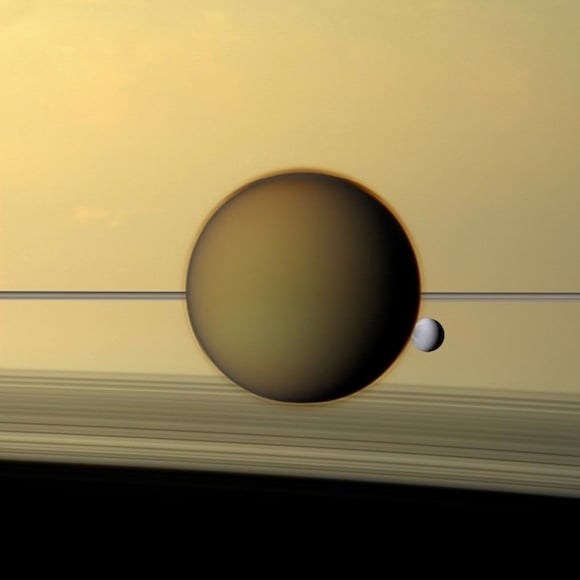This article is more than 1 year old
Plastic ingredient FOUND ON MOON of Saturn
Near, far, wherever you are (on Titan)
A NASA spacecraft sniffing the smoggy atmosphere of Titan has found traces of the chemical used to make plastic containers.
The robotic Cassini probe has detected propylene on Saturn's moon - the first time this chemical has been found out in space. Titan is a thoroughly unpleasant world with a brownish atmosphere, liquid methane rain and freezing temperatures that can plummet to a frosty -180°C.
As if the place wasn't nasty enough, space boffins now know that it is home to detectable quantities of propylene, which is a key ingredient in food containers as well as car bumpers.
NASA used Cassini's Composite Infrared Spectrometer (CIRS) to scan the hazy atmosphere, measuring the heat radiation emitted as infrared light from the moon in a process that NASA described as being similar to "the way our hands feel the warmth of a fire".
The first chemical the scientists discovered using the CIRS was propylene, which was identified in small quantities at various altitudes throughout the lower levels of the soupy hydrocarbon fog found in the moon's noxious skies.
"This chemical is all around us in everyday life, strung together in long chains to form a plastic called polypropylene," said Conor Nixon, a planetary scientist at NASA's Goddard Space Flight Center in Greenbelt, Maryland, and lead author of a paper describing the findings.
"That plastic container at the grocery store with the recycling code 5 on the bottom - that's polypropylene."
Voyager 1 was the first probe to discover that Titan's brown atmosphere was made up of hydrocarbons, which are the building-block chemicals in petrol and other fossil fuels. The moon also boasts huge lakes thought to be made of liquid methane and ethane, which would be the only bodies of standing liquid we've found on a moon or planet (other than Earth, of course).
The hydrocarbons in the moon's atmosphere are formed when sunlight breaks down this methane, which also exists in the form of a gas on Titan. During a flyby in 1980, Voyager first detected propane, used to power camping stoves, and propyne, a gas that is sometimes used as a welding torch fuel.

Cassini's one-way holiday snap ... the moons Titan (left) and Dione (right) against Saturn
However, fast-forwarding to today, NASA boffins wanted to use Cassini's more sophisticated instruments to work out exactly which other molecules were present. After poring over the results, they were surprised to see propylene.
"This measurement was very difficult to make because propylene's weak signature is crowded by related chemicals with much stronger signals," said Michael Flasar, a scientist at NASA's Goddard Space Flight Center. "This success boosts our confidence that we will find still more chemicals long hidden in Titan's atmosphere."
The space scientists are delighted with the discovery – as is the El Reg science desk if it means that one day astronauts travelling through space will be able to stop off on Titan to manufacture their very own plastic food containers and other stuff (if enough propylene can be found).
"I am always excited when scientists discover a molecule that has never been observed before in an atmosphere," said Scott Edgington, Cassini's deputy project scientist at NASA's Jet Propulsion Laboratory in Pasadena, California. "This new piece of the puzzle will provide an additional test of how well we understand the chemical zoo that makes up Titan's atmosphere."
The Cassini-Huygens mission is a cooperative project of NASA, the European Space Agency and the Italian Space Agency.
A full report on Cassini's findings was published in this month's Astrophysical Journal Letters. ®
